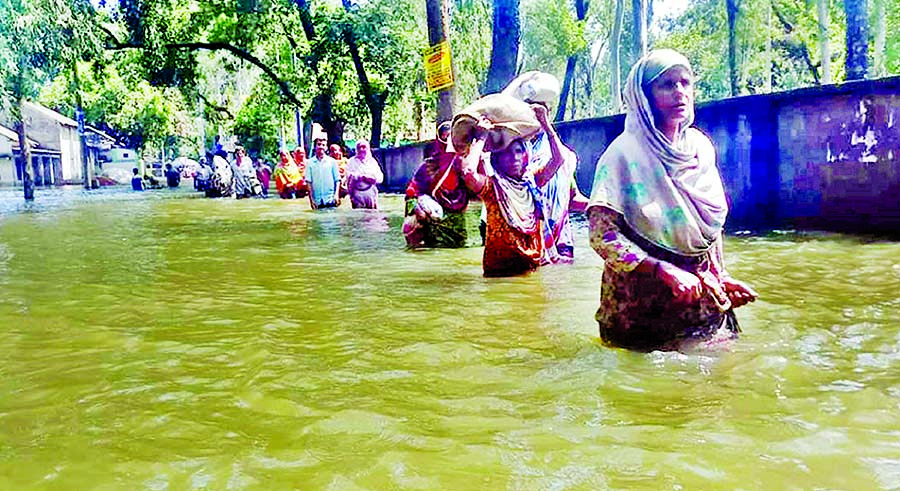
News Desk :
Nearly a million people remained stranded, facing acute shortage of food, drinking water and fodder as the flood situation worsened.
Heavy downpour in the upstream regions adjacent to Bangladesh and in the district pushed up the water level of Brahmaputra and Dharla rivers on Thursday.
Dharla was flowing 73 centimetres above the danger level at Bridge Point. Brahmaputra, on the other hand, was 36 centimetres above the danger level at Chilmari point in the morning.
The rivers burst their banks and submerged low-lying areas of 50 villages. Besides, the road from Bangtur Ghat to Phulbari Dam is at the risk of erosion while a 50-foot stretch of Nagrakura dam in Ulipur upazila caved in.
Officials of the Water Development Board, and the upazila administration said steps will be taken to repair the dam immediately.
During this two-week flood, 9,58,327 people in nine upazilas of the district remained stranded. An estimated 20,000 hectares of cropland are feared to have been damaged.
Many flood victims from the remote regions complained that they are yet to receive any relief material.
Meanwhile, water level of the Brahmaputra river and the Ghagot river started rising again making the flood hit people of the district more worried and panic.
The officials of Bangladesh Water Development Board said water level of the Brahmaputra river rose by 10 cm in last 24 hours and was flowing 43 cm above its danger mark at Fulchharighat point of the district on Thursday morning at 6 am. On the other hand, the Ghagot river also experienced rise by 4 cm during the period and was flowing 22 cm above its danger level at New Bridge Road point of the district town on Thursday morning at 6 am.
Additional deputy commissioner (General) Alamgir Kabir Saikat said around 5,95,000 people of Sundarganj, Sadar, Fulchhari and Shaghata upazilas of the district have been marooned.
As many as 98,000 people have taken shelter at 190 school, college and madrashas which are being used as flood shelter centers, he also said. Apart from it, thousands of flood victims have taken shelter at the government embankments, higher places and relatives’ houses with domestic animals, poultry birds and other belongings, he added.
The incessant rainfall has increased the sufferings and sorrows of the flood victims who had been residing on the flood control embankments for few days last making temporary chala with CI sheet and bamboo chatai, he further added.
The health department also took pragmatic measures so that water borne diseases like diarrhea, cholera and dysentery were not broken out in alarming form in flood prone areas here, said civil surgeon (CS) Dr. ABM Abu Hanif.
A total of 109 medical teams led by medical officers have working in the flood affected areas of the district round the clock to check any types of water borne diseases, he also said.
Control rooms had also been opened at his office of the district town and at the offices of upazila health and family planning officers to help the flood hit people take health related services and suggestions, the CS added.
To mitigate the sufferings of the flood victims, relief distribution activity by the district and the upazila administrations had also been intensified and it had been continuing for couples of weeks.
Deputy Commissioner Abdul Matin told the BSS that 1,380 tonnes of rice, TK 20 lakh and 6000 cartoons of dry food received from Relief and Disaster Management Ministry had been distributed to the flood hit people of the district so far.

